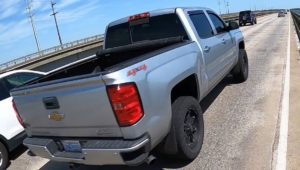Larger Vehicles Making are making an impact ON OUR ROADS
It may or may not be true that larger vehicles are safer for those inside them. It is certainly not true for vulnerable road users that they collide with. The increasing prevalence of large vehicles on our roadways is making our roads increasingly unsafe for pedestrians, cyclists and other vulnerable road users. According to a recent Times Union article, in 2021 Truck SUV’s, “car” SUV’s and pickups represented 72 percent of the market compared to only 26% for sedans and wagons. Truck SUVs weighing 6000 pounds or more represented 45% of the 2021 market. As recently as 2013 sedans and wagons represented just over 50% of the market.
While sedans and wagons purchased in prior years will still be on the road for a long time, the percentage of larger vehicles is growing over time. This is reflected in fatality statistics for vulnerable road users. In NY the percentage of pedestrian fatalities attributable to passenger cars was 41% versus 45% for all trucks (which includes pickups and suvs). In 2020, the last year with figures available, those figures had changed to 36% for passenger cars and wagons and 54% for trucks. New Scientist reported back in December of 2003 that an SUV was more than twice as likely to kill a pedestrian as a sedan traveling at the same speed.
Why THEY Do More Damage
The larger vehicles are more dangerous for several reasons. First is the larger mass. At the same speed a vehicle of greater mass will do more damage to a vulnerable road user. Second is the shape of the vehicle. The higher front ends of these vehicles will tend to deliver more upper body and head injuries.
Unlike an impact of a large SUV or pickup for a vulnerable road user, a sedan or wagon may turn one impact into several impacts of lesser severity. When a sedan struck my bicycle in Washington Park in 2019, the vehicle first broadsided my bicycle, striking my left pedal. I was thrown onto the roof of the vehicle and glanced off the roof falling behind the car. I landed helmet first into the street. The kinetic energy of the impact was divided between the vehicle striking the bicycle, my impact on the roof, the impact of my helmet on the road, the impact of my head into my helmet and the rest of my body onto the road. It hurt, but I didn’t break a bone. If the vehicle was a Ford F150 or other SUV with a large front end, there would pretty much be one impact with a much larger mass and my outcome would not have been so fortunate.
That higher front end also makes it more difficult for drivers to see people that are near the vehicle – especially smaller people like children. This is especially dangerous in dense urban environments where visibility is already restricted by limited site lines, the density of traffic and the busier landscape where drivers have so much more to take notice of. Not only are collisions with vulnerable users more severe with these huge vehicles, they are more likely.
Our Roads and Laws Must Change
The physics of our roads have changed. People are driving larger vehicles. They are driving their vehicles faster. They are driving their vehicles with less attention. The laws of physics are not on the side of vulnerable road users. The laws of physics can’t be changed. The laws of the road need to change. We need vehicles that are designed to save the lives of people outside the vehicle in the event of a collision. We need to slow vehicles down in places where there are vulnerable road users. We need to design our roads to minimize the chances of collisions between motor vehicles and vulnerable road users

Bicycle Route to Kitty Hawk, NC
“It may or may not be true that larger vehicles are safer for those inside them. It is certainly not true for vulnerable road users that they collide with.”